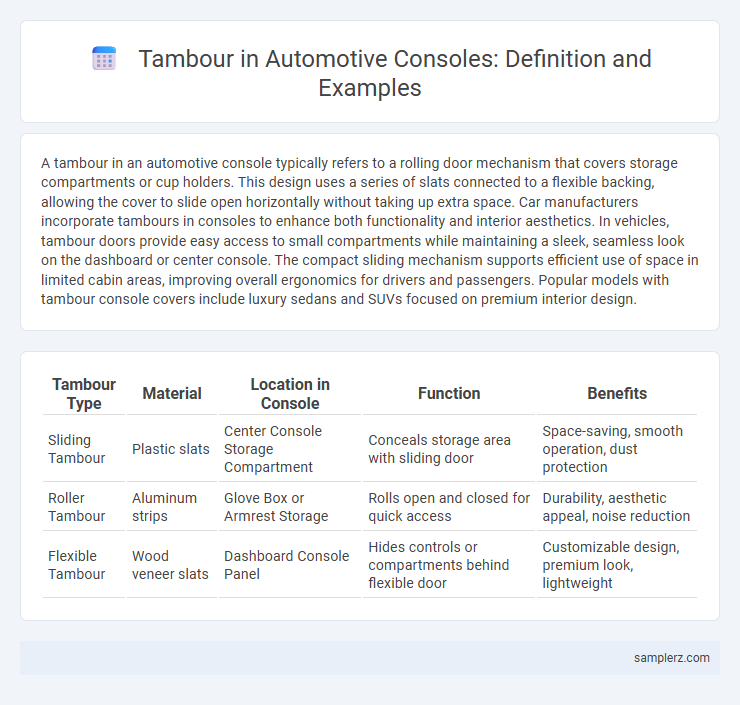A tambour in an automotive console typically refers to a rolling door mechanism that covers storage compartments or cup holders. This design uses a series of slats connected to a flexible backing, allowing the cover to slide open horizontally without taking up extra space. Car manufacturers incorporate tambours in consoles to enhance both functionality and interior aesthetics. In vehicles, tambour doors provide easy access to small compartments while maintaining a sleek, seamless look on the dashboard or center console. The compact sliding mechanism supports efficient use of space in limited cabin areas, improving overall ergonomics for drivers and passengers. Popular models with tambour console covers include luxury sedans and SUVs focused on premium interior design.
Table of Comparison
| Tambour Type | Material | Location in Console | Function | Benefits |
|---|---|---|---|---|
| Sliding Tambour | Plastic slats | Center Console Storage Compartment | Conceals storage area with sliding door | Space-saving, smooth operation, dust protection |
| Roller Tambour | Aluminum strips | Glove Box or Armrest Storage | Rolls open and closed for quick access | Durability, aesthetic appeal, noise reduction |
| Flexible Tambour | Wood veneer slats | Dashboard Console Panel | Hides controls or compartments behind flexible door | Customizable design, premium look, lightweight |
Overview of Tambour Doors in Automotive Consoles
Tambour doors in automotive consoles provide a space-saving solution by sliding horizontally along curved or straight tracks, enabling easy access to storage compartments without requiring additional clearance. These doors are commonly made from flexible materials like slats of plastic, wood, or metal, offering durability and smooth operation within limited cabin space. Their compact design enhances interior aesthetics and functionality, making them ideal for center consoles in modern vehicles.
Key Benefits of Tambour Consoles in Modern Vehicles
Tambour consoles in modern vehicles maximize interior storage efficiency by utilizing flexible, rolling shutter doors that save space and provide easy access to stored items. These consoles enhance ergonomic design, allowing drivers and passengers to quickly reach essential controls and personal belongings without disrupting the cabin's sleek aesthetics. Their durable materials and smooth operation contribute to long-lasting functionality and improved vehicle organization, making tambour consoles a preferred choice in automotive interior design.
Popular Materials Used for Tambour Console Doors
Tambour console doors in automotive interiors frequently utilize durable materials such as ABS plastic and polycarbonate for their lightweight properties and impact resistance. Wood veneer with a flexible backing is also popular, providing a premium look while maintaining the necessary flexibility for smooth operation. Aluminum slats coated with powder finishes offer enhanced durability and a sleek metallic appearance, making them a favored choice in luxury vehicle designs.
Design Trends in Automotive Tambour Consoles
Automotive tambour consoles showcase sleek, space-saving design trends with retractable slatted covers made from lightweight materials like aluminum or composite plastics, enhancing both functionality and aesthetics. These tambour doors offer seamless integration into modern vehicle interiors, providing easy access to storage compartments while maintaining a clean, minimalist look favored in luxury and electric vehicles. Innovations include customizable finishes, wireless charging pads beneath tambour covers, and noise-dampening mechanisms to improve user experience and cabin ambiance.
How Tambour Mechanisms Enhance Cabin Functionality
Tambour mechanisms in automotive consoles provide smooth and space-efficient access to storage compartments, improving overall cabin ergonomics. Their flexible slatted design allows for quiet, seamless opening and closing, enhancing user comfort and reducing noise. By integrating tambours, manufacturers optimize dashboard and center console layouts, maximizing usable space while maintaining aesthetic appeal.
Comparison: Tambour vs Traditional Storage Solutions
Tambour storage in automotive consoles offers a space-saving, flexible design compared to traditional fixed compartment storage, enhancing cabin ergonomics and user accessibility. Unlike rigid compartments, tambour panels slide seamlessly, providing easier access to contents without occupying additional space, which is crucial for maximizing interior vehicle dimensions. The integration of tambour storage also contributes to modern vehicle aesthetics, combining functionality with sleek design elements in contemporary car interiors.
Notable Car Models Featuring Tambour Console Designs
Several notable car models showcase tambour console designs, including the Rolls-Royce Phantom, which incorporates a sleek tambour door for its storage compartments, combining luxury with practicality. The Mercedes-Benz S-Class features tambour consoles that enhance the interior's elegant aesthetic while providing smooth access to controls and storage. Jaguar's F-Type also adopts tambour-style elements in its center console, emphasizing seamless design and user convenience.
Maintenance Tips for Automotive Tambour Consoles
Automotive tambour consoles require regular cleaning with a soft, damp cloth to prevent dust and debris accumulation that can impair the rolling mechanism. Applying a silicone-based lubricant to the tambour slats ensures smooth operation and reduces wear over time. Inspecting for loose components or damaged slats regularly helps maintain optimal functionality and prolongs the console's lifespan.
Customization Options for Tambour Doors in Cars
Tambour doors in automotive consoles offer versatile customization options such as adjustable materials including wood veneer, brushed aluminum, and high-gloss carbon fiber to match interior themes. Configurations with integrated ambient lighting and soft-close mechanisms enhance usability and aesthetic appeal. Color finishes can be tailored to complement dashboard designs, providing seamless integration with luxury and sport vehicle interiors.
Future Innovations in Tambour Console Applications
Future innovations in tambour console applications include the integration of smart materials that enable adaptive flexibility and enhanced durability for automotive interiors. Advanced automation technologies are being employed to create seamless, noise-reducing tambour mechanisms that improve user experience and cabin ergonomics. The incorporation of IoT connectivity in tambour consoles allows for personalized environmental controls and intuitive interaction with vehicle infotainment systems.

example of tambour in console Infographic
 samplerz.com
samplerz.com